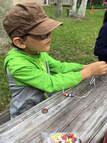|
Talking About
Florida Homeschooling... Evaluations and More |
A good evaluator works for the parents, assisting them in meeting legal requirements and in supporting them when districts overstep their bounds." |
|
Q: How do you teach home economics at home? --- A: Some people just involve their children in their daily living. The child gets involved in cooking, cleaning, mending, sewing, etc. as parents do it or as the child is curious and asks questions about different jobs. Others are more formal about it. It's up to you, of course, and what works for you. Personally, we did a mixture. I involved the children early on in helping mix and cook and sew and such. I even drew up lists to walk them through steps involved in washing laundry or cleaning the bathroom and showed them how to do each step but kept the list up for years to help them work through the tasks. But I also liked the idea of some more formal learning to make sure they learned a variety of basic skills.
When mine were in elementary grades, we used a home economics textbook written specifically for homeschoolers called Home Economics for Homeschoolers from Pearables which covered skills like peeling vegetables and cooking simple dishes as well as cleaning and sewing skills. We also used a local library's crochet club to help teach crocheting and later a homeschool group's knitting club to teach knitting. These may be hard to find these days with the pandemic, but there are lots of YouTube channels with videos to help your child (and perhaps you, too) learn such skills. We also used some 4-H curriculum to teach sewing skills; you can purchase and use their curriculum even if you don't join one of their clubs. In the middle school years, I had them use a cookbook called How to Cook without a Book. This book was designed to teach principles of cooking so they'd know enough to be able to throw a meal together without having to find a recipe--a skill that comes in handy when very busy and may make the difference between them cooking at home as adults or surviving on less-healthy and more-expensive restaurant options. They continued with 4-H and made dishes and fiber items that were displayed in the local fair and won prize money for them--which is nice for the self-esteem and their pocketbooks. If done in high school, these can be awards to list on a transcript and perhaps help with college admissions, too, as an added bonus. When one of my teens wanted to get much better at sewing, knitting, and crocheting in high school, we found several videos to help and she spent a lot of time developing her own designs and learning to follow patterns, too. Art & Design: Fiber Arts (Advanced) was the title we eventually settled on to describe her year of creating dozens of lovely items including a huge sampler afghan. Creating our own class meant she was able to learn the skills she wanted to learn and wasn't bogged down with repeating lessons on skills she'd already mastered. We kept records of the items she made and the skills learned as well as the awards won and titles of videos and books she used; these were useful in compiling a course description for this homemade course. And though he may not be as passionate about these skills, her brother can make his way around the kitchen, clean the house, and sew on a button or mend something if needed. Ours isn't the only way to learn these skills, but hopefully, these give you some ideas of the options available. Cheryl Trzasko Homeschool mom and evaluator for 18 years [email protected]
1 Comment
10/12/2021 02:50:56 am
This article piqued my interest. Because of its unique content, it is well worth reading. This is an excellent piece!
Reply
Your comment will be posted after it is approved.
Leave a Reply. |
Archives
April 2024
Categories
All
|

 RSS Feed
RSS Feed






